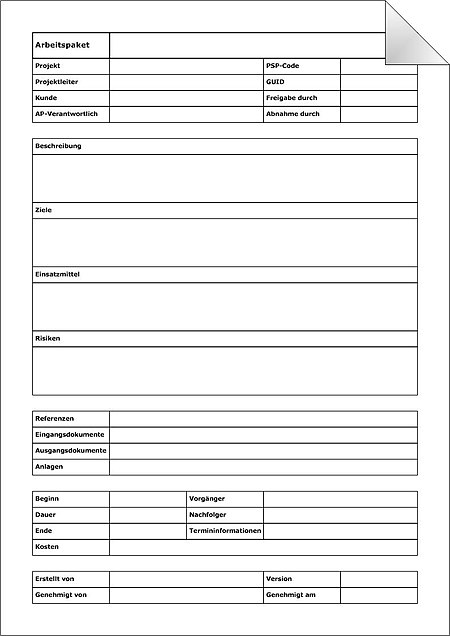Work package
The work package (AP) (ger .: work package ; abbreviated WP) is a plan and controllable element in a project that is not further subdivided. Work packages are created within a work breakdown structure .
- "A work package is a self-contained task that can be completed by a specified point in time with a defined result and effort [.]"
meaning
Work packages play an important role in project planning. They contain results targets and describe services and deliveries that can be achieved or provided under specified conditions. They are the basis for the schedule and process planning, resource planning and cost planning to be carried out later, and the findings from work packages also flow into the risk planning. The total content of all work packages from the project structure planning must be identical to the content of the project.
Work package description
The work package description is the document that describes all information, content and conditions of the work package. This document is usually created in tabular form.
- Identifiers
- Information that is able to identify the work package precisely, such as a PSP code, a GUID and also the name or designation of the work package.
- Project information
- To which project does the work package belong, who is the project manager and who is the project customer.
- description
- A text that describes the work package and the services to be provided in such a way that the purpose and content are comprehensible for everyone involved.
- aims
- The result targets to be achieved in the work package, if applicable. also secondary goals linked to the work package, such as E.g. social goals.
- Explanations
- Additional notes that supplement or clarify the description or the objectives.
- Responsibilities
- Mention of the person responsible for the work package and description of who is allowed to approve and / or approve and under what conditions. In the early planning stages, these responsibilities may be U. assigned generically (if the position, position or qualification is mentioned without a specific name).
- credentials
- Laws, standards or regulations that must be observed for processing.
- Risks
- Technical, operational and other risks that are linked to the work package and should be transferred to the risk register.
- Expiration information
- Information about the predecessor and successor of the work package under consideration and the associated additional information that is later important for the network plan calculation or comparable methods.
- Appointment information
- Information on appointments, especially mandatory appointments, process durations, target or blocking intervals.
- Resources needed
- Information on required employees and their qualifications as well as the work to be done by them in a unit of time, on necessary equipment, on existing or to be purchased material or internal or external services to be provided.
- Cost information
- Reference to estimated costs, possibly in the form of estimates or calculations.
- Incoming documents
- Documents (plans, drawings, instructions, etc.) that must be provided for processing the work package.
- Source documents
- Documents that are created within the work package and passed on to subsequent work packages.
- Investments
- Documents that are attached to the work package description for explanation or another purpose.
- Signatures
- Information on the creator, creation date, version and scope of the work package description.
In practice, templates are used for work package descriptions, which, designed as a maximum solution, can also take on the function of checklists.
regulate
The following rules should be observed when creating work packages.
- responsibility
- There must be someone responsible for each work package. In addition to the technical responsibility for providing information for the work package, the flow of information within the work package and for passing on information to the following bodies, the person responsible for the work package is responsible. Depending on the form of the project organization, he may not necessarily be responsible for the discipline.
- Assignment
- A work package should be clearly assigned to a project phase. This does not apply to cross-sectional tasks or project support processes, such as Project controlling or quality management.
- External services
- Tasks that are outsourced to subcontractors in the form of external services are to be defined as independent work packages. (Several subcontractors should not be active here within one work package.)
- specification
- A clear formulation of the specification should be possible for each work package. The performance within a work package must be clearly distinguishable from the performance in other work packages.
- Reasonable duration
- Compared to the entire project duration, the duration of the work package must not be too long in order to be able to identify delays in deadlines in good time.
- Reasonable cost
- Compared to the total project costs, the budgeted cost value should not be too small in order to achieve a reasonable cost-benefit ratio for project monitoring.
- Level of detail
- All work packages of a project should have approximately the same level of detail.
